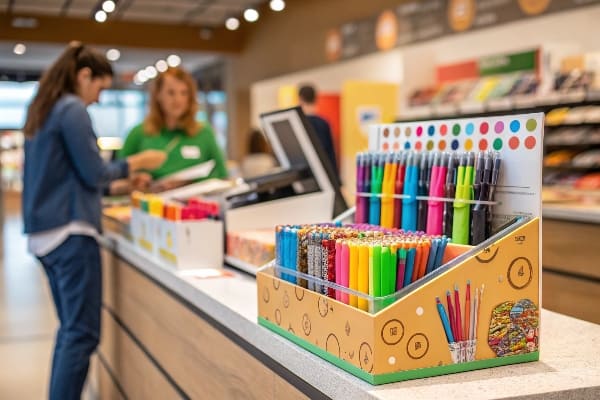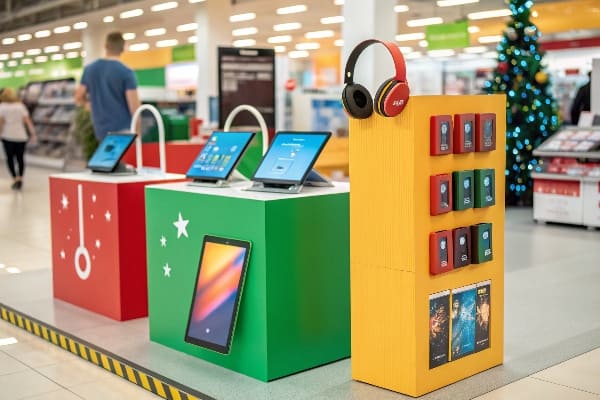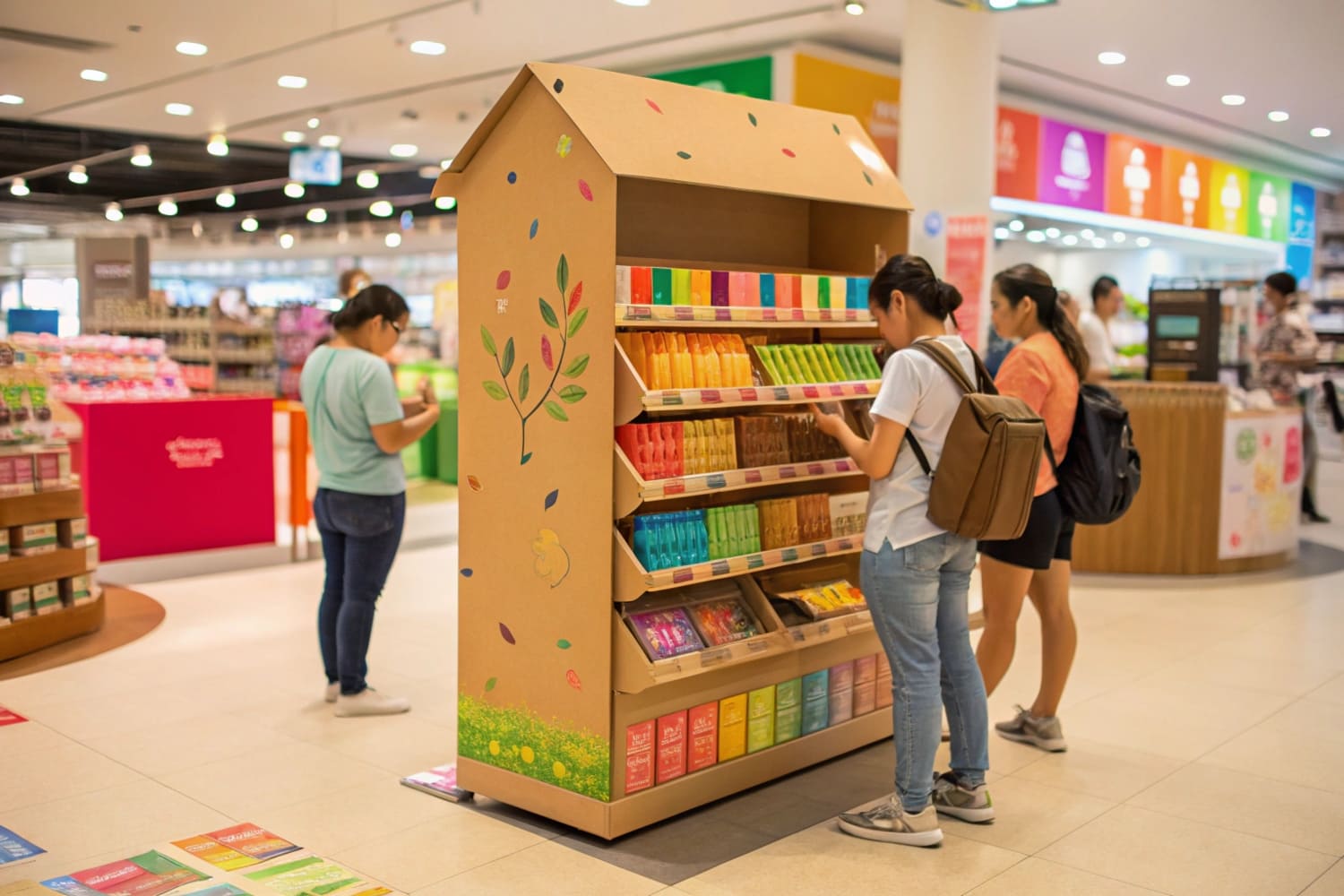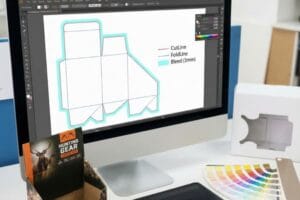许多采购人员在选择哪些产品用于POP和POS展示时感到束手无策。上市日期临近,但展示方案仍然模糊不清。
传统上在 POP 和 POS 展示架上销售的产品包括零食、饮料、糖果、化妆品、个人护理用品、小型电子产品、玩具、季节性商品、礼品套装以及电池、打火机和旅行装产品等低价附加商品。

我在中国经营一家纸板展示架工厂,所以每天都能在客户的订单上看到这些产品。他们大多销往北美和欧洲。我知道买家在这里最关心的是一些非常简单的问题:这个展示架能否快速促进产品销售,能否安全运输,以及店员能否在三秒钟内看懂。在本文中,我将分享我在实际的POP和POS项目中反复看到的几种产品类型,并提供清晰的示例供您参考,以便您将其应用到自己的品牌中。
流行音乐的一个例子是什么?
有时我会和买家交谈,他们会说:“我的老板想要一个促销展示架,但我不知道实际的展示架在商店里是什么样子。”
商品陈列中一个经典的 POP 例子是,在过道中放置一个独立的纸板落地展示架,上面摆放着袋装零食或瓶装饮料,远离普通货架,以吸引注意力并促进冲动消费。

我在项目中看到的典型POP展示示例
当我与客户讨论促销点 (POP) 时,我们通常会站在落地展示架¹ 促销点陈列的重中之重² 。它位于人流密集区域,而非普通货架上。通常,它只展示一个主打 SKU,或许还会搭配一两个辅助 SKU。其目标很简单:吸引顾客驻足观看,并将更多商品放入购物车。
以下是我反复构建的一些常见 POP 示例:
| 产品类别 | 显示类型 | 通常位置 | 为什么起作用 |
|---|---|---|---|
| 薯片和糖果 | 地板显示 | 主通道或通道尽头 | 醒目的品牌标识和大量的库存展示 |
| 能量饮料3 | 托盘或落地式展示架 | 靠近入口或电源通道 | 醒目的品牌标识和价格标示 |
| 化妆品4 | 阶梯式落地展示架 | 美容专区 | 清晰的测试结果和色号故事 |
| 玩具和游戏 | 倾倒箱或地面单元 | 季节性商品或玩具货架 | 有趣的形状和适合儿童的设施 |
| 狩猎配件 | 落地式展示架 | 户外或运动通道 | 许多SKU采用垂直布局 |
我最喜欢的POP(促销展示)项目之一是为一家在美国销售弩配件的户外品牌做的。他们之前的产品平放在一个长长的货架上。我们把它们搬到了一个带挂钩的高落地展示柜里,并配上了醒目的生活方式图片。之后,客户告诉我,狩猎季期间他们的销量大幅提升,因为消费者终于可以在一个地方看到全系列产品,并将它们与一个强有力的品牌故事联系起来。
哪个是流行购买点的示例?
很多人还会把促销品(POP)和“普通标牌”混淆。他们认为促销品仅仅是指货架顶部的宣传卡片,因此错失了过道里的重要销售机会。
POP 销售点展示的一个明显例子是预先包装好的饮料或零食托盘,用印刷纸板包裹,放置在仓储式会员店人流量大的区域,直接从托盘上出售。

我最常看到的POP展示形式
当买家向我咨询“一款强力促销展示架5 ”时,他们很少会想要一个简单的货架托盘。他们需要的是一种能够快速上架、容纳大量商品,并且在众多顾客触摸后依然保持清洁的展示架。因此,我通常会引导他们选择一套经过验证的小型促销展示架6 。
我用简单易懂的方式解释如下:
| POP格式 | 典型产品 | 最佳购物区 |
|---|---|---|
| 托盘显示7 | 饮料、散装零食、宠物食品 | 仓储式会员店,大型超市主通道 |
| 地板塔 | 糖果、饼干、小型电子产品 | 过道间隙,靠近货架末端 |
| 垃圾箱 | 玩具、毛绒玩具、清仓商品 | 季节性区域,前巷 |
| 端盖套件8 | 新口味,新品上市 | 通道尽头面向主干道 |
| 强力边锋/副手 | 电池、小型工具、试用装 | 端盖或冷却器的侧面 |
在与一家美国零售商合作的一个项目中,我为一款新型能量饮料设计了一套托盘展示架。采购人员非常注重速度,要求展示架能够快速从拖车搬运到销售区域,且几乎无需额外操作。我们设计了一种全瓦楞纸板托盘包装,采用醒目的图案和简易的撕开式门。工作人员只需剪开几道线,即可将托盘推到指定位置。由于该展示架兼具运输和销售功能,因此节省了人力,并帮助品牌在产品上市的第一周就向消费者展示了大量的商品。
什么是流行商品?
许多品牌只注重展示效果,而忽略了产品本身。他们设计出漂亮的展示柜,但包装却不合适,或者与产品理念不符。
POP 商品是指专门为销售点展示而制作、包装或捆绑的产品,通常是特殊包装、多件装或限量促销品,以支持店内活动。

我如何与客户一起规划POP商品
当我着手制定新的陈列方案时,我从不从设计图稿入手,而是从商品计划是辅助产品?这次活动是以价格为导向还是以故事为导向?只有回答了这些问题,我们才能选择合适的促销包装。
以下是常见POP商品类型的简要介绍:
| POP商品类型 | 示例包 | 主要目标 |
|---|---|---|
| 超值多件装11 | 三包零食或饮料 | 增加购物篮尺寸 |
| 试用装或迷你装12 | 小管装化妆品或乳霜 | 鼓励首次试验 |
| 礼品套装 | 弩及配件套装,一盒装 | 增加感知价值和礼品赠送 |
| 主题混音 | “赛季开幕”狩猎配件套装 | 与活动或季节相关 |
| 奖励包 | “额外赠送 10%”套装 | 创造强烈的价值信号 |
我曾帮助一位化妆品客户设计新产品线的落地展示架,但他们原先的单包装产品摆放在架子上显得太小。我们改变了方案,制作了包含增值小礼品的礼盒套装,并明确标明“仅此一家”。更新后的商品不仅填满了整个展示架,还减少了我们需要管理的SKU数量,并让顾客有充分的理由选择购买礼盒套装。同样的道理也适用于狩猎产品。展示包含箭矢、弓蜡和安全装备的完整弩“入门套装”的展示架,通常比把许多单件商品散落在货架上更能吸引顾客。
什么是销售商品?
许多买家在电子邮件中看到“POS”这个词,但仍然不确定它具体指什么。他们知道它与结账有关,但也将其与一般零售联系起来。
POS 商品陈列是指在销售点(通常是收银区或服务柜台)对商品进行摆放、推广和管理的方式,利用展示架、标牌和小装置来促进最后一刻的购买。

POS 商品陈列13POP 14的区别
我去商店考察陈列时,总会在收银区多待一会儿。这里是收银台商品陈列的关键所在。空间有限,顾客的注意力一半集中在付款上,一半又在想着买些零食或补买遗漏的商品。因此,收银台的商品陈列必须简洁明了、快速便捷。
以下是我向客户解释POP和POS区别的方式:
| 方面 | 流行音乐 | pos |
|---|---|---|
| 主要地点 | 通道、端架、电源通道 | 收银台、服务台 |
| 购物者心态15 | 浏览,敞开胸怀探索 | 准备付款,注意力不集中 |
| 典型产品16 | 核心SKU,明星产品发布 | 小件、低风险、冲动消费品 |
| 显示屏尺寸 | 中型至大型落地单元或托盘 | 小型台面或悬挂式展示架 |
| 主要目标 | 提升品牌知名度和库存量 | 每篮额外添加一到两件商品 |
在我自己的工厂里,POS机展示架项目通常来自销售小型配件的品牌。例如,一个狩猎品牌可能会在户外用品商店的收银台旁放置一个薄纸板柜台展示架,用来摆放蜡、绳子或小型工具。这种展示架占地面积小,但利润率很高。我们在设计这些展示架时,会认真考虑收银员每天的使用体验。它必须稳固、易于补充商品,并且不能遮挡支付设备。当POS机陈列设计能够兼顾门店员工和收银流程时,门店会更长时间地保留这些展示架,品牌也能获得更好的长期收益。
结论
POP 和 POS 展示品最好采用清晰的产品定位、简单的包装,以及与真实购物者和真实商店相匹配的强大设计和商品陈列基础。
点击此链接,了解落地式陈列如何提升零售环境中的商品可见度并促进销售。 ↩
探索 POP 商品陈列的原则,有效吸引顾客并增加冲动性购买。 ↩
探索能够提升能量饮料品牌知名度和销量的创新展示策略。 ↩
了解阶梯式陈列如何吸引顾客并有效展示化妆品。 ↩
了解构成一个强大的促销展示单元的要素,可以帮助您创建能够吸引顾客的有效零售展示。 ↩
探索行之有效的 POP 展示形式,可以帮助我们深入了解成功的展示策略,从而提高产品可见度和销量。 ↩
探索托盘展示如何提升零售环境中的产品可见度并促进销售。 ↩
了解端架陈列套件在提升客户参与度和增加销售额方面的战略优势。 ↩
了解商品计划对于有效的零售策略和最大化销售额至关重要。 ↩
研究促销包装可以帮助我们了解吸引顾客的有效营销技巧。 ↩
探索超值多件装如何提升零售环境中的销售额和顾客满意度。 ↩
了解试用装对鼓励新客户尝试产品的影响。 ↩
了解POS商品陈列可以提升您的零售策略,使收银区更加高效和吸引人。 ↩
了解 POP 和 POS 之间的区别可以帮助您优化商品陈列策略,从而更好地吸引顾客。 ↩
了解消费者的心理可以增强您的营销策略并提高客户参与度。 ↩
研究典型产品可以帮助您优化产品摆放位置并提高销量。 ↩





